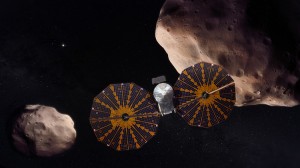Lucy Heads for the Skies
Wednesday, November 3rd, 2021
The Lucy spacecraft flies past the Trojan asteroid 617 Patroclus and Menoetius in this artist’s rendering.
Credit: NASA Goddard
It’s not every day that the National Aeronautics and Space Administration (NASA) launches a new spacecraft. Their latest, named Lucy, was launched Oct. 16, 2021, from Cape Canaveral Space Force Station in Florida. Its mission? Explore the Trojan asteroid belt near the orbit of Jupiter. Lucy doesn’t have a crew, but the craft is equipped with powerful telescopes and cameras to gather information about the mysterious asteroids.
Lucy won’t be taking a direct path to Jupiter’s orbit, however. The spacecraft will use a series of gravity assists to help move it closer to its target. In a gravity assist, a spacecraft uses momentum gained from swinging by a planet to adjust its path and fling it toward a target.
After spending a year orbiting the sun, Lucy will return to Earth’s orbit for its first gravity assist in October 2022. This assist will set it on a course it toward Mars. In 2024, a second gravity assist will send Lucy towards the main asteroid belt, between the orbits of Mars and Jupiter. On this orbit, Lucy’s telescopes and cameras will capture images of asteroid 52246 Donaldjohanson. The probe should arrive at the Trojan asteroid belt by 2027.
Each of the asteroids in the Trojan belt is named after a different hero from the Greek epic the Iliad. The first Trojan Lucy will photograph is Eurybates in August 2027. Eurybates is unique because it has a smaller moon orbiting it, named Queta. Polymele will be photographed in September 2027, and Leucus and Orus will be photographed in April 2028 and November 2028, respectively. After that, Lucy will return to Earth for one more gravity assist. In 2033, Lucy will finish the mission by visiting the Trojan asteroids Patroclus and Menoetius. The spacecraft will remain in orbit around the asteroids, studying the asteroids for as long as it continues to function.
The Trojan asteroids were named after Greek myths, but what about Lucy? Usually, NASA uses acronyms for naming spacecraft. An acronym is a word that uses the first letter of each word in a phrase to create a new word, for example referring to the National Aeronautics and Space Administration as NASA. In Lucy’s case, however, they named the craft after a fossilized skeleton found in 1974, in Ethiopia. Lucy wasn’t exactly a human – she represented a species of hominin called Australopithecus Afarensis. Hominins are a group of living things that includes human beings and early humanlike ancestors.
The expedition that found the skeleton Lucy was led by the anthropologist Donald Johanson and his student Tom Gray. An anthropologist is a scientist who studies humans and their close relatives. They were looking for fossils, and on Nov. 24, 1974, they found one of the most significant fossils to date. With 40 percent of her recovered, Lucy represents one of the most complete skeletons ever found from her time, dating to about 3.18 million years ago. When the team returned to their camp the night they found the first fossils, they celebrated their finding by listening to music and partying. One of the songs on repeat that night was “Lucy In The Sky With Diamonds,” a song by British rock band The Beatles. Pamela Alderman, a member of the team, gave the fossil hominid they found the nickname “Lucy” after the song. Just as Donald Johanson was the first to discover the fossil Lucy, the spacecraft Lucy will be the first to study asteroid 52246 Donaldjohanson, named in the anthropologist’s honor.



